
Advertisement
Retail home improvement chain Lowe’s has announced that it will stop selling deadly pesticides suspected of causing colony collapse disorder (CCD) and the death of honeybees worldwide. The announcement follows the moratorium on permits for these pesticides sent out by the Environmental Protection Agency (EPA).
At present, about two-thirds of the bee population worldwide is in domesticated hives. With one-third of all food crops pollinated by honeybees, this ban and Lowe’s support thereof are a step in the right direction toward restoring the declining bee population.
What is colony collapse disorder?
The term colony collapse disorder (CCD), a phenomenon that occurs when the entire colony of a hive disappears, was coined in 2006 when the winter die-off of bee colonies reached more than 30 percent. A normal year sees a 10 percent die-off of hives, but some beekeepers reported losses as high as 70 percent.
CCD happens when the majority of worker bees in a colony disappear and leave behind a queen, plenty of food and a few nurse bees to care for the remaining bees and the queen. According to the EPA, here are some of the factors that cause CCD:
- Increased losses due to the invasive varroa mite (a pest of honey bees).
- New or emerging diseases such as Israeli Acute Paralysis virus and the gut parasite Nosema.
- Pesticide poisoning through exposure to pesticides applied to crops or for in-hive insect or mite control.
- Stress bees experience due to management practices such as transportation to multiple locations across the country for providing pollination services.
- Changes to the habitat where bees forage.
- Inadequate forage/poor nutrition.
- Potential immune-suppressing stress on bees caused by one or a combination of factors identified above.
Movement towards banning pesticides
In 2014, a study conducted by the Harvard School of Public Health discovered that the probable cause of the decline of honeybees was pesticides. Cities such as Eugene, Oregon; Seattle and Spokane, Washington; and Skagway, Alaska, have already banned the use of these pesticides on any city-owned land. Even the USDA has voiced concerns about CCD and its effect on our food and beverage crops.

President Obama also established a national Pollinator Health Task Force in 2014, after the European Commission banned the use of three neonicotinoids on flowering plants in 2013: clothianidin, imidacloprid and thiamethoxam. The European Food Safety Authority also found that these chemicals were toxic to bees, causing, “high acute risks.”
The EPA moratorium is on permits for outdoor use of the pesticides. Research has now pointed to the use of neonicotinoids as harmful to bees, birds, other beneficial insects and wildlife.
“EPA considers the completion of the new pollinator risk assessments for these chemicals to be an agency priority.” No further permits will be issued by the EPA until, “the data on pollinator health have been received and appropriate risk assessments completed,” the EPA stated in their letter. Permits that have already been granted, however, may still be used.
Sources used:
Submit a correction >>
This article may contain statements that reflect the opinion of the author
Advertisement
Advertisements















